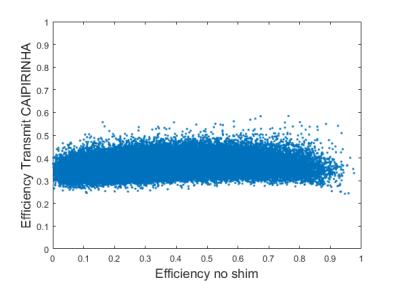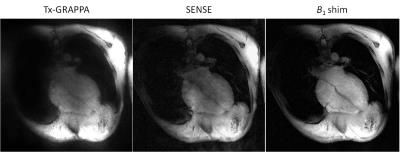2666
Ultra-high-field CAIPIRINHA modulated parallel transmit excitation for homogenous image reconstruction without RF shimming1Diagnostic Imaging, MR, Siemens Healthcare Ltd, Frimley, United Kingdom, 2Radcliffe Department of Medicine, University of Oxford, Oxford, United Kingdom
Synopsis
Ultra-high-field (UHF) provides higher SNR than conventional, clinically available field strengths. However, UHF suffers from heterogeneous transmit B1+ fields. At 7 T, the shortened transmit radio-frequency (RF) wavelengths have a similar value to the dimensions of the human head/thorax which may result in signal cancellation and local signal dropouts. In this paper, we propose a novel imaging scheme based on simultaneous excitation with all transmit channels. Controlled aliasing is used to encode each transmit channel independently which we term Tx-CAIPIRINHA.
Tx-CAIPIRINHA has been demonstrated in-vivo. The concept uses the linear superposition of B1+ fields via the excitation flip angle which only holds true in the low flip angle regime. When normalizing to transmit efficiency, Tx-CAIPIRINHA achieved a marginally higher SNR than B1+ shimming, demonstrating the constructive combination of transmit sensitives throughout the image.
Introduction
Ultra-high-field (UHF) provides higher SNR than conventional, clinically available field strengths. However, UHF suffers from heterogeneous transmit (B1+) fields [1]. At 7 T, the shortened transmit radio-frequency (RF) wavelengths have a similar value to the dimensions of the human head/thorax which may result in signal cancellation and local signal dropouts.
Radio-frequency shimming with multiple channel excitation of a parallel transmit (pTx) array is a well established method to increase the transverse magnetic field homogeneity at high magnetic field strength [2]. To perform RF shimming, relative transmit sensitivity maps are acquired. They are used to determine the combination of amplitudes and phases to either maximize the minimum B1+ or minimize the coefficient of variation throughout a region of interest. However, as the field of view increases, the excitation efficiency reduces to account for larger variation until that there is no satisfactory shim solution [3]. Subject motion between adjustment mapping and image acquisition means that the optimal B1+ solution can change [4]. Time interleaved acquisition of modes (TIAMO) [5] addresses the B1+ heterogeneity by combining two different transmit modes. In this paper, we propose a novel imaging scheme based on simultaneous excitation with all transmit channels. Controlled aliasing is used to encode each transmit channel independently which we term Tx-CAIPIRINHA
Methods
Cardiac measurements were performed in two healthy volunteers on a whole-body research 7Tesla MR-system (Siemens Healthcare GmbH, Erlangen, Germany). Healthy volunteer measurements were acquired according to our institutions ethical practices. Data acquisition was performed with a custom built eight-channel transmit/receive cardiac transverse electro-magnetic (TEM) coil.
Images were acquired using a modified non-product, gradient-echo (GRE) sequence allowing simultaneous transmit with controlled aliasing for each transmit channel. This was achieved by introducing a different phase modulation for each transmit channel resulting in a different shift within the FOV of excitation resulting from each transmitter. The increments in phase from one line to the next ranged from 0° to 315° in steps of 45° for each transmit channel. To calibrate the receive and transmit sensitives, low resolution, low flip angle, transmit maps were acquired by transmitting on one Tx channel at a time [6]. The acquisition parameters of the GRE sequence are: TR=9.64ms,TE =1.68 ms, acquisition matrix=352x352, FOV=350x350mm2. Single-slice images of 4mm thickness were acquired during four cardiac cycles in a single breath hold. For comparison purpose, an image of the same slice with identical orientation and RF pulse voltage was acquired using B1+ shimming.
Aliased images formed when transmitting on all channels were reconstructed using Tx channel–GRAPPA (Tx-GRAPPA) algorithm similar to slice-GRAPPA [7]. A 7×7 GRAPPA kernel is separately fitted in k-space to each transmit channel of the calibration data. In the case of the Tx-GRAPPA method, after reconstruction of separate images for each transmit and receive channel, the images were combined. First, images from all the receivers were combined with a root sum-of-squares (rSoS) reconstruction incorporating the noise covariance matrix. In the second step, rSoS reconstruction was performed along the transmit dimension.
For comparison a conjugate gradient iterative SENSE reconstruction was also employed [8] where the product of transmit and receive sensitivities was used to form an 8x8 or 64 virtual channel SENSE reconstruction. This method provides one combined image.
Results
A simulation of the efficiency (ratio to maximum B1+ possible) was performed for 100,000 random B1+ fields of an 8 channel system when using Tx-CAIPIRINHA and was compared to no B1+ shimming. The average attained flip angle is well behaved and it is approximately 1/√N-TxChannels i.e. 1/√8, compared to no B1+ shimming. The result of this simulation is summarized in fig.1.
Figure 2 shows the reconstructed images using Tx–CAIPIRINHA with a 7×7 GRAPPA kernel (a), iterative SENSE (b) and B1+ shimming (c). The efficiency of the applied B1+ shim was 67% compared to an expected 35% for Tx-CAIPIRINHA (Fig 1) a ratio of 1.9:1.
Both methods Tx-GRAPPA and iterative SENSE produced similar results with high signal homogeneity in the heart. This was achieved without any prior operator adjustment of the B1+ field of each transmit channel.
Discussion
Tx-CAPIRINHA has been demonstrated in-vivo. The concept uses the linear superposition of B1+ fields via the excitation flip angle which only holds true in the low flip angle regime. When normalizing to transmit efficiency, Tx-CAIPIRINHA achieved a marginally higher SNR than B1+ shimming, demonstrating the constructive combination of transmit sensitives throughout the image. This method has a number of further advantages over RF shimming, including no operator involvement to perform B1+ shimming and no limit to field of view size.Acknowledgements
No acknowledgement found.References
[1] Vaughan JT, Garwood M, Collins CM, Liu W, DelaBarre L, Adriany G, Andersen GP, Merkle H, Goebel R, Smith MB, Ugurbil K. 7T vs. 4T: RF power, homogeneity, and signal-to-noise comparison in head images. Magn Reson Med. 2001; 46:24–30
[2] Van de Moortele PF and Uburbil K. Very Fast Multi Channel B1 Calibration at High Field in the Small Flip Angle Regime” ISMRM 2009, pp 367
[3] Schmitter S, DelaBarre L, Wu X, Greiser A, Wang D, Auerbach EJ, Vaughan JT, Ugurbil K, Van de Moortele PF. Cardiac Imaging at 7T: Single- and Two-Spoke RF Pulse Design with 16-channel Parallel Excitation Magn Reson Med. 2001; 46:24-30
[4] Schmitter S, Wu X, Ugurbil K, Van de Moortele PF. Design of parallel transmission radiofrequency pulses robust against respiration in cardiac MRI at 7 Tesla. Magn Reson Med. 2015; 74:1291-1305
[5] Orzada S1, Maderwald S, Poser BA, Bitz AK, Quick HH, Ladd ME. RF excitation using time interleaved acquisition of modes (TIAMO) to address B1 inhomogeneity in high-field MRI. Magn Reson Med. 2010; 64:327-333
[6] Padormo F, Hess AT, Aljabar P, Malik SJ, Jezzard P, Robson MD, Hajnal JV, Koopmans PJ. Large dynamic range relative B1+ mapping. Magn Reson Med. 2016; 76:490-499
[7] Setsompop K, Gagoski BA, Polimeni JR, Witzel T, Wedeen VJ, Wald LL. Blipped-controlled aliasing in parallel imaging for simultaneous multislice echo planar imaging with reduced g-factor penalty. Magn Reson Med. 2012; 67:1210-1224
[8] Pruessmann KP, Weiger M, Börnert P, Boesiger P. Advances in sensitivity encoding with arbitrary k-space trajectories. Magn Reson Med. 2001; 46:638-651
Figures

